Primal Q&A
We talk to Chris Sorrell, creative director at SCEE's Studio Cambridge, about the upcoming PlayStation 2 action game.
Primal is an upcoming third-person action game for the PlayStation 2. The game is being internally developed by SCEE's UK-based Studio Cambridge, which has been working on the game for quite some time. We caught up with the creative director of Studio Cambridge, Chris Sorrell, to find out how the game is coming along.
GameSpot: We first covered Primal on GameSpot back in May 2001. Could you tell us how the game you're working on now compares to the original vision?
Chris Sorrell: The very first vision for Primal was a little different from the game we're now completing. It was more grounded in mythological themes and structured around tarot--essentially it was well summed up by its original working title of "Fable." As real development began and we started to really define the game's look and feel, we realized it would work better to make things a little less magical and a lot more physical. Inspired by the attitude and themes of TV series like Buffy, Angel, and Dark Angel, we introduced the idea of the demon races and gave Jen, our heroine, the ability to transform into them. All of this happened a long time back now, and from that point forward (once the vision really became clear), we've stuck pretty closely to it. 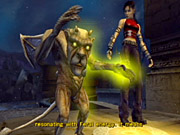
GS: How is the game structured? Will players be required to complete levels in a set order, or do they explore at will, uncovering missions as they do so?
CS: The gameworld consists of four different demon realms and a fifth hub area that joins them. The storyline follows Jen from initial events in the real world and onwards into the demon realms. Along the way she learns secrets about her past, acquires the ability to shift into four different demon forms, and evolves into a true action hero responsible for restoring balance to the four realms and turning back the Chaos that has been unleashed upon them. So the game is certainly very story driven and essentially linear; however, each world is pretty vast, and the flow of events within them is pretty complicated--you have plenty of freedom to explore.
GS: What can you tell us about Jennifer Tate? How does she come to be charged with battling the forces of Chaos?
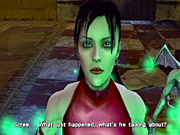
CS: She starts as an ordinary person. This is quite important because we've tried to ground the game in reality, to inject real life and emotion into the characters and to make the environments believable and consistent. To make this possible we felt it was important to introduce the more fantastical aspects of the game gradually--to take the player on the same journey as Jen is undertaking herself (in the same way a good superhero film like Spider-Man introduces Spidey only after establishing the character and motivations of Peter Parker). Jen's change begins when she and her boyfriend are attacked by a huge demon as they're leaving a nightclub. Jen is smashed to the ground, and her last, fading vision is of her boyfriend Lewis being carried away by the monster. The game begins with Jen in hospital where her spirit is awoken by a small stone gargoyle--Scree. He leads her off into a realm called Oblivion where the forces of Order and Chaos are in eternal conflict. She discovers that Chaos is starting to prevail, and Oblivion, not to mention our own world, will suffer terrible consequences if this is allowed to continue. Jen is somewhat cynical of the notions Scree is presenting to her, but when he mentions that Lewis may be here, she immediately latches on to this. By the time she learns that she is half demon herself, she is well and truly caught up in Scree's cause--to restore Order to the realms.
GS: We've heard that Jennifer's character changes as she progresses through the game and unlocks demonic abilities. Could you tell us a little more about how this will impact the gameplay?
CS: Jen is just getting used to the idea of demons and Oblivion when events force her into adopting her first demon form. Unsurprisingly this is quite a traumatic process, and this and each subsequent form she gains have quite an effect on her. From the gameplay perspective the changes are pretty evident. The first form--ferai--makes her much tougher, able to run faster, to jump higher. All the demon forms are able to manifest special energy weapons via the armlets that Jen wears. In ferai form, her weapons are vicious claws. The second form--undine--gives Jen the ability to dive and swim. Her weapons are energy tentacles that lash out to give range to her attacks. The first two races that Jen encounters are essentially good, but the last two are very much allied with Chaos. Jen's transformation into these forms brings out a darker side to her personality (with several gameplay consequences!). In wraith form, Jen is able to warp time--to perform dash moves, both in and out of combat. She fights with an energy whip and a short spiked weapon for closer attacks. Her final form is that of the volcano-dwelling djinn race. In this form she fights with two fire swords, which can also be merged into a single huge blade.
GS: And what about her companion, the gargoyle called Scree? We understand that players will be able to switch between the two characters. 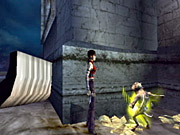
CS: Yes, throughout the game you can choose whether to control Jen or Scree. Each has their own abilities, and, as in the SNES classic Lost Vikings, you'll often need to think about which character is best to tackle a particular aspect of the game.
GS: Are the controls for the two characters pretty much the same, or do they have very different moves and abilities?
CS: For basic movement, the characters' abilities and controls are equivalent. However, each character has a specific focus--for Jen this is combat and for Scree exploration. Each of these things adds additional controls to the basic set for that character. One of Scree's special abilities is to be able to climb any stonework surface. This sees him crawling around Spider-Man style with the camera following his twists and turns.
GS: Was a two-player cooperative mode ever discussed for Primal?
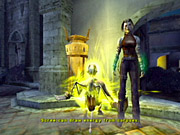
CS: Not for Primal 1, no. We had more than enough ambitious elements on our task lists as it was. Obviously this might be an interesting option to consider further in a potential sequel.
GS: We've also heard that Scree will be able to possess statues in the game. How exactly does that work? Could you perhaps give us an example from the game?
CS: Scree is effectively a living statue, so his statue-possession ability is really an extension of this--he can temporarily shift his soul into other forms. As the players progress, they'll encounter a number of statues that glow as Scree approaches--these are the possessable ones. Different statues open up different possibilities. Some are relatively simple puzzle components, while others are effectively new controllable characters. The first major example of this would be a point in the game where the players are attacked by the same huge demon that we see in the intro. It's way too big for Jen to fight, but Scree is able to possess the towering statue of a legendary hero and in this form is able to fight on equal terms with the monster.
GS: How does combat work in the game? Will players be able to switch between characters midbattle in the same way beat-'em-ups allow you to in tag mode?
CS: We decided right from the start that the point of having two characters was to give each differing abilities, to add a real point in choosing when to play each one. Considering Scree's small stature and Jen's demonic strength, we decided to make a clear split between them where combat is concerned: Jen fights, Scree stays out of the way (he turns to stone). So the combat mechanic definitely revolves around Jen, but Scree does play a part. One of his general abilities is to collect and store the energy that Jen requires to maintain her demon forms. He effectively acts like a mobile battery; Jen can summon energy from him whenever she requires it, including during combat.
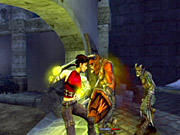
GS: Is the combat purely fisticuffs-based, or will players have access to melee and projectile weapons?
CS: Jen's weapons are all close-range (nonprojectile). We decided to go this route so that we could focus on creating a combat system more akin to a proper beat-'em-up--Soul Calibur being our most notable inspiration. As a result, Primal has a very in-depth combat system for an action adventure, featuring left and right attacks of varying strengths, super attacks, combo attacks, blocks, parries, and counterattacks. Each of the weapons Jen uses in her demon forms add their own new subtleties and fighting styles to the mix.
GS: Could you tell us a bit about the fantasy world of Mortalis that you've created for the game? Does it resemble our own world in any way?
CS: Well, Mortalis is really the demon name for our world, and aside from the fact that demons obviously do exist, this is our world, and Jen starts out as just an everyday girl living in it. Once the game begins, and Jen is led by Scree into Oblivion, then we start to see the demon realms. First is the Nexus--really just a convergence point. Solum, Aquis, Aetha, and Volca are the four demon realms in which the game is really set. The realms represent a set of balanced properties--seasons, time of day, climate, etc.--and each is home to a demon race that reflects the nature of their environment. From a design point of view, since we wanted to make the realms as real and consistently styled as possible, each takes inspiration from a real historical source. As a couple of examples: Solum is based on Roman architecture and society, albeit one populated by a savage, tribal race of demonic hunters. By contrast, Aetha is based around Napoleonic France--a cruel class of aristocratic demons lead a decadent existence preying upon a sickly peasant underclass for their blood.
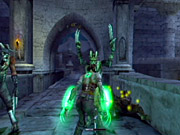
GS: How many different types of monsters are there in the game, and do the different types exhibit different behaviors in different situations?
CS: In each realm we have several classes of character. There are wild animal types that see Jen as food. One type scuttles over rooftops and down the sides of buildings before coming in to attack--pretty creepy looking. More-intelligent enemies tend to be the guards or sentries within the different realms. We actually have a system for creating many permutations of each enemy type so as to avoid the gamey cliché of everyone looking like clones. This system extends to the characters' AI and fighting styles. Different characters will fight quite differently--some might be very defensive but perhaps prone to losing their calm if taunted, and some might be more relentless in their attacks, requiring Jen to fight more defensively herself. There are also quite a few special characters that are introduced by the story and which you may end up having to fight. There are over 20 distinctly different standard enemy types, each with a number of variations, and six boss enemies. There are about another 20 NPCs that you'll meet along the way. All in all there are probably around a hundred visually different characters in the game.
GS: How important do you think it is to have good voice acting in games nowadays? We believe you've signed up one or two big names for Primal?
CS: Story-driven games have to feature a strong script and high-quality acting or else cutscenes can start to drag very quickly. We took a long time over the script, working with an external scriptwriter until we reached a version we were happy with. We also spent a long while deliberating over casting--our primary consideration not so much to get big names as to get people that were just right for the parts. Being a bunch of sci-fi geeks (well some of us anyway), many of the actors who came to mind were stars of some of the big-name TV sci-fi series. For Scree we needed a voice that suggested a kind of ageless wisdom at the same time as great strength (we were adamant that he not sound like some funny little sidekick because his character is way bigger than that). The only voice that seemed right to us was that of Andreas Katsulas, well known for playing a character called G'Kar in Babylon 5. For Jen we needed someone that could cover the spectrum from breezy humor to snarly malevolence, and the perfect example of this was Xena's Callisto, played by Hudson Leick. Thankfully we were able to convince both actors to work with us.
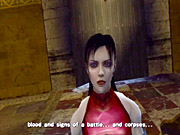
GS: You're clearly working with a powerful graphics engine. Could you tell us about some of the things it allows you to do that you couldn't do otherwise?
CS: It's not any one thing that makes our engine special so much as the combination of features it provides--features like animation blending, multitexturing, reflection mapping, dynamic lighting, projected shadows, level of detail, various particle-effect systems, cutscene handling, advanced sound handling, procedural trees, and a full dynamic loading system for streaming data of all types. So, lots of cool stuff. But to be honest all of this would count for nothing if it weren't for the fact that we've also had a lot of talented and dedicated people working all hours to actually build the game.
GS: Finally, if you could give a single piece of advice to anyone starting to play Primal, what would it be?
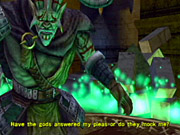
CS: Don't forget that Scree can offer quite a lot of hints as you're playing, and the in-game map provides a lot of useful information too. Oh, and don't go skipping all the cutscenes--they contain a lot of important plot information!
GS: Chris, thanks for your time.
Got a news tip or want to contact us directly? Email news@gamespot.com
Join the conversation